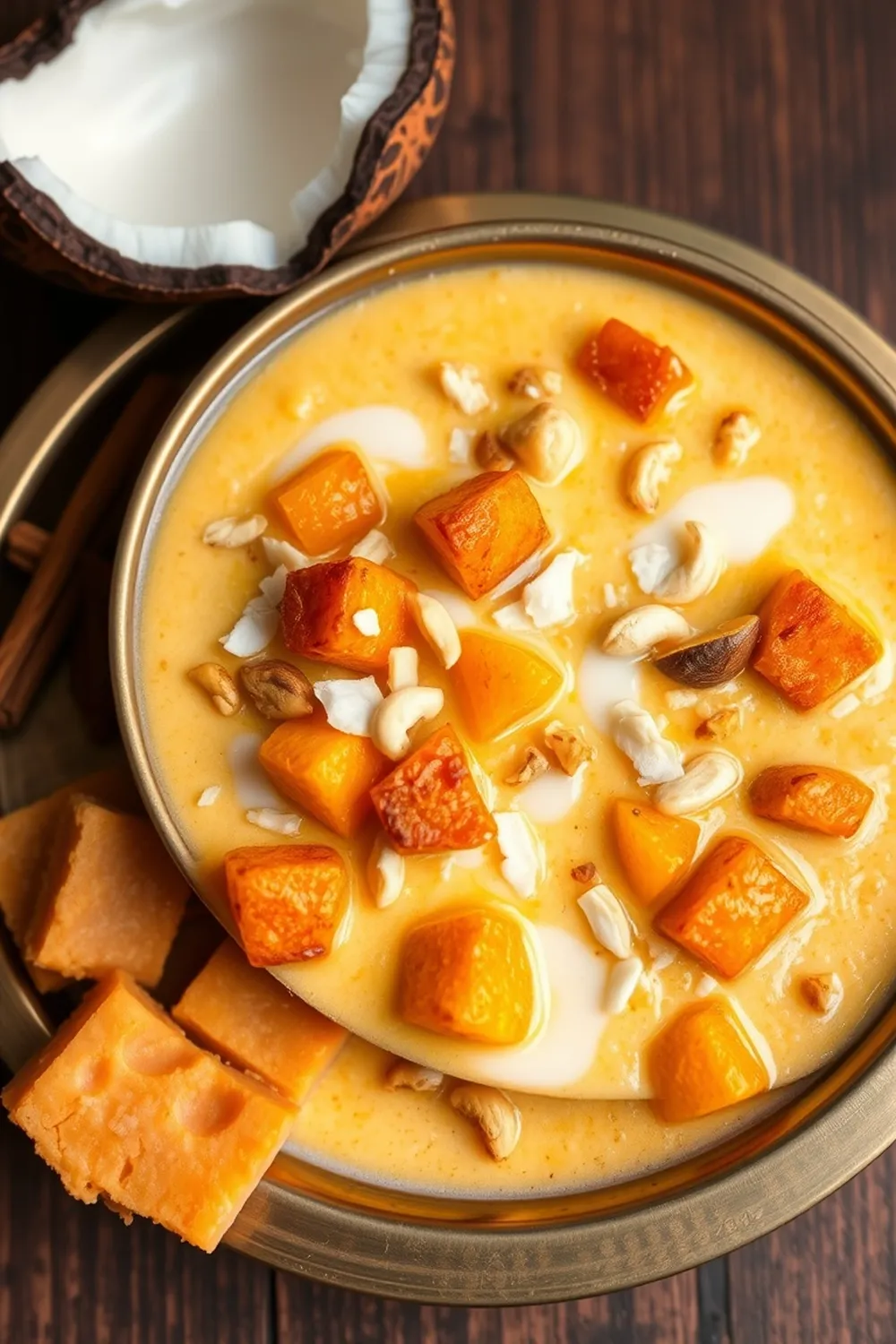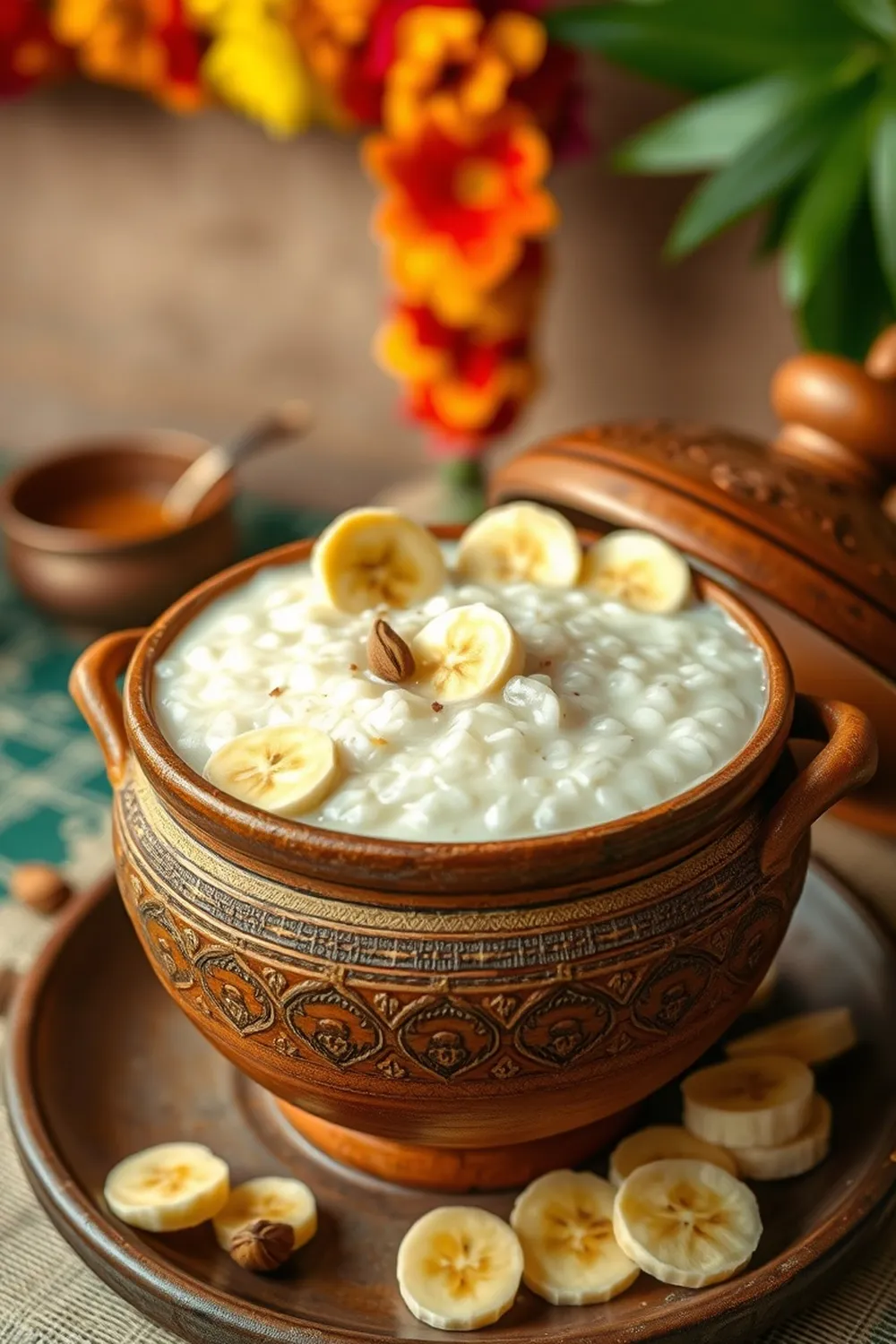- Soak sago in water for 30 minutes. Drain and cook in 1.5-2 cups of water until soft. Rinse under cold water and set aside.
- Melt jaggery with 1/2 cup water, strain to remove impurities, and set aside.
- Heat 3 tbsp ghee in a pan. Add grated pumpkin and sauté on low heat for 12-15 minutes until tender.
- Mix melted jaggery into cooked pumpkin. Cook for 10-12 minutes until the mixture thickens and leaves the pan’s sides.
- Pour medium-thick coconut milk into the mixture. Simmer until reduced and thickened, then add cooked sago.
- Stir in thick coconut milk and simmer for 7-8 minutes. Add crushed cardamom and remove from heat.
- Fry chopped pumpkin, coconut pieces, and cashews in 2 tbsp ghee until golden. Garnish the payasam before serving.
- Calories:350 kcal25%
- Energy:1464 kJ22%
- Protein:5 g28%
- Carbohydrates:55 mg40%
- Sugar:35 mg8%
- Salt:50 g25%
- Fat:18 g20%
Last Updated on 2 months by Neha Deshmukh
Pumpkin Sago Payasam Recipe – Authentic Kerala Sweet with Jaggery
Introduction
Oh, Payasam! Is there anything more comforting? This Pumpkin Sago Payasam (Mathanga Pazham Payasam) holds a very special place in my heart. It’s a recipe my grandmother passed down, and it always reminds me of festive Onam celebrations back home in Kerala. It’s a beautiful blend of sweet pumpkin, tiny sago pearls, and the rich, creamy goodness of coconut milk – all tied together with the warm spice of cardamom. Trust me, one spoonful and you’ll be transported!
Why You’ll Love This Recipe
This isn’t just any payasam; it’s a taste of Kerala tradition. It’s relatively easy to make, even if you’re new to Indian desserts. The combination of pumpkin and sago is surprisingly delightful, and the jaggery adds a depth of flavour you just won’t get with sugar. Plus, it’s naturally gluten-free! It’s the perfect sweet treat for festivals, celebrations, or just a cozy night in.
Ingredients
Here’s what you’ll need to create this Kerala classic:
- 550 gms Pumpkin (with skin, grated)
- 1/3 cup Sago (small pearl variety)
- 3-4 tbsp Pumpkin (chopped – for garnish)
- 250-300 gms Jaggery
- 2.5 cups Medium thick coconut milk
- 1.25-1.5 cups Thick coconut milk
- 1/2 cup Coconut bits (Thengakothu)
- 10-12 Cashew nuts
- 3 Cardamom (crushed)
- 5 tbsp Ghee
Ingredient Notes
Let’s talk ingredients! Getting these right makes all the difference.
- Coconut Milk: This recipe really shines with authentic Kerala-style coconut milk. You’ll need both medium-thick and thick coconut milk. The difference in consistency is key to achieving that perfect creamy texture. If you can’t find pre-made, you can make your own by grating fresh coconut and extracting the milk.
- Jaggery: Good quality jaggery is essential. It lends a beautiful caramel-like flavour that sugar just can’t replicate. Look for a dark amber colour – that indicates a richer flavour.
- Thengakothu (Coconut Bits): These are a traditional addition, adding a lovely texture and subtle coconut flavour. They’re readily available in South Indian grocery stores.
- Sago: I prefer using the small pearl sago for this payasam. It cooks quicker and gives a nice, delicate texture. Larger pearl sago works too, but you’ll need to adjust the cooking time.
Step-By-Step Instructions
Alright, let’s get cooking!
- First, soak the sago in water for about 30 minutes. This helps it become nice and plump. Once soaked, drain it well and cook it in 1.5-2 cups of water until it’s soft and translucent. Rinse under cold water to stop the cooking process and set aside.
- Now, let’s tackle the jaggery. Melt the jaggery with about ½ cup of water in a pan. Strain it through a fine-mesh sieve to remove any impurities – this ensures a smooth payasam. Keep the melted jaggery warm.
- Heat 3 tablespoons of ghee in a separate pan. Add the grated pumpkin and sauté on low heat for 12-15 minutes, or until it’s tender and slightly browned. Patience is key here – low and slow is the way to go!
- Pour the melted jaggery into the cooked pumpkin. Cook for another 10-12 minutes, stirring constantly, until the mixture thickens and starts to leave the sides of the pan.
- Now for the creamy goodness! Pour in the medium-thick coconut milk and simmer until the mixture reduces and thickens further. Then, gently add the cooked sago and stir well.
- Stir in the thick coconut milk and simmer for 7-8 minutes, allowing the flavours to meld. Finally, add the crushed cardamom and remove from the heat.
- For the final touch, fry the chopped pumpkin, coconut bits, and cashew nuts in 2 tablespoons of ghee until golden brown. Garnish the payasam with this crunchy mixture before serving.
Expert Tips
A few little secrets to payasam perfection:
- Consistency is Key: The payasam should be creamy but not too thick. Adjust the amount of coconut milk if needed.
- Don’t Overcook the Sago: Overcooked sago becomes mushy. Rinse it well after cooking to stop the process.
- Low Heat is Your Friend: Sautéing the pumpkin on low heat prevents it from burning and ensures it cooks evenly.
Variations
Want to put your own spin on things? Here are a few ideas:
- Vegan Adaptation: Swap the ghee for a plant-based alternative like coconut oil. Use almond or cashew milk instead of dairy milk.
- Gluten-Free: This recipe is naturally gluten-free, so you’re good to go!
- Spice Level: If you love a stronger cardamom flavour, feel free to add a little more.
- Festival Adaptations: During Onam or Vishu, some families add a pinch of nutmeg for extra warmth. My aunt always does!
Serving Suggestions
This payasam is delicious served warm or at room temperature. It’s wonderful on its own, but you can also pair it with a side of papadum or a simple banana.
Storage Instructions
Leftover payasam can be stored in an airtight container in the refrigerator for up to 3 days. It might thicken upon cooling, so you can add a splash of milk when reheating.
FAQs
Let’s answer some common questions:
- What type of pumpkin is best for this payasam? Yellow pumpkin (Mathanga) is traditionally used, but you can also use butternut squash.
- Can I use sugar instead of jaggery? What adjustments should I make? Yes, you can! Use about ¾ cup of sugar for every 1 cup of jaggery. You might also want to add a tiny pinch of salt to balance the sweetness.
- How do I know when the sago is cooked perfectly? The sago should be translucent with a tiny white dot in the center. It should be soft but not mushy.
- What is Thengakothu and can I substitute it? Thengakothu is grated coconut that’s toasted until golden brown. If you can’t find it, you can use shredded coconut, lightly toasted in a dry pan.
- Can this payasam be made ahead of time? Yes, you can make it a day ahead. The flavours actually develop even more overnight!
- How can I adjust the sweetness level of the payasam? Start with less jaggery and add more to taste. Remember, you can always add sweetness, but it’s hard to take it away!










